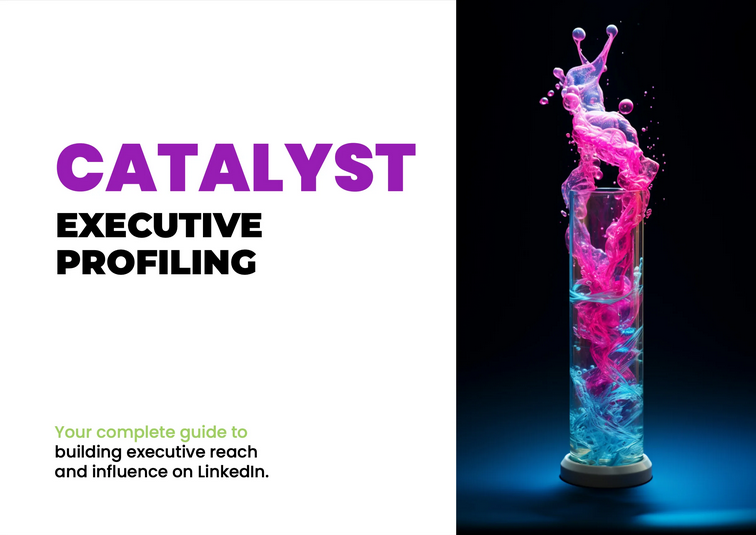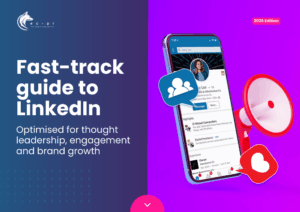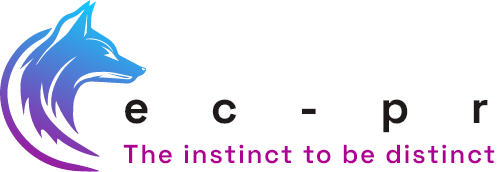
9 Reasons why CEOs & executives should be active on LinkedIn
LinkedIn isn’t just a networking tool; it’s a strategic communications platform that allows CEOs and business leaders to build their personal brand, foster business relationships, and showcase their company’s values.
With over 1 billion members in more than 200 countries, LinkedIn offers a unique and powerful space for executives to connect, share expertise, and position themselves as industry leaders. For those in the B2B sector, a strong CEO LinkedIn strategy can directly enhance visibility, customer trust, and business success.
Why is LinkedIn important for business leaders?
If you are a CMO, marketing leader or company leader, embracing LinkedIn isn’t optional; it’s critical.
LinkedIn can increase leads, open doors to new opportunities, enhance your company’s reputation, and even attract top talent. Moreover, it’s one of the most underused and cost-effective ways to boost your business.
Here’s why your C-suite should be active on LinkedIn and how it can drive outstanding brand engagement.
Expand your network and build business relationships
LinkedIn is a dynamic social media tool to connect with peers, potential partners, leaders in their industry and industry influencers. By being active on LinkedIn, senior executives can expand their network, build relationships, and learn from others.
We have seen one B2B-focused MD increase their network (followers) by 141% in less than a year. Moreover, their network became more engaged with their posts – which has consolidated partnerships and collaborations and led to diverse new business leads.
Boost visibility of your company and the CEO
A strong executive leadership presence on LinkedIn can boost the visibility and reputation of your company.
People buy from people they trust. So, when business leaders are active on LinkedIn and are sharing their expertise, insights, and values with the world, they are likely to attract their own community of followers, who will engage and refer them to people they know and trust. We all know that personal referrals hold more weight. And so not being active on LinkedIn is wasting a massive opportunity.
We have seen one CEO of a tech communications firm grow their company’s visibility simply by posting a thoughtful mix of personal leadership insights and business commentary. This strategy broadened substantially the firm’s reach and contacts and helped establish them as a trusted expert in its field.
This is a prime example of LinkedIn best practices for executives: use the platform to humanise your brand and position your leadership front and centre.
Attract top talent
LinkedIn is a great way to attract top talent. Job seekers can follow your company and leaders’ profiles, so if you’re not active there, you’re certainly not impressing anyone. Job hunters can also check out current and past employees to see how they might fit into the team, and you can reach out with a direct message that might feel more personal than one on a job-search platform. This makes it particularly suitable for recruiting into smaller companies.
By showcasing your company’s leadership culture and values on LinkedIn, you can support recruitment efforts there and on additional recruitment websites.
Demonstrate thought leadership in your industry
Senior executives can more quickly establish themselves as thought leaders by sharing their passion, insight and experience on LinkedIn. Content regularly shared by business leaders through articles, answering questions, and engaging in discussions on LinkedIn, demonstrates their expertise and knowledge.
For example, the CEO of a renewables software company could write timely posts commenting on the latest industry trends, evolving technologies, or related news items. This would help position the CEO as a thought leader and commentator in the climate tech industry and build a community of interest.
Generate leads and drive business growth
Engaging content that shows how you can solve clients’ problems can generate leads and drive potential clients to your company. When business leaders share relevant experiences, business/life lessons, client stories and nuggets of wisdom on LinkedIn, they are demonstrating their understanding of their clients. This will attract and assure potential customers by speaking their language and offering solutions in a personal way.
For example, an MD posting on LinkedIn about a recent positive or negative experience in the workplace can attract more engagement because this resonates with other people too. Asking for questions, opinions or suggestions is another great way to engage with the people you’re trying to help in your business. Prospects are more likely to get in touch with you when they need your services (even if they don’t interact with you at the time).
Increase customer retention
A dynamic, relatable personal profile at the most senior executive level supports client retention, by being accessible and demonstrating shared values. When business leaders are active on LinkedIn, they are building relationships with their customers in a very human way. This helps to create customer loyalty and encourage repeat business.
For example, the operations director of an engineering company could give personal thanks to stakeholders during projects and celebrate client successes too. Being responsive and supportive on LinkedIn can help build trust and loyalty with customers and draw your clients closer to advocacy.
Use as leverage for crisis management
An active presence on LinkedIn can help you be prepared to address crises promptly and professionally. When business leaders are active on LinkedIn, they have a platform to communicate with their customers, employees, and the public during a crisis.
For example, if a company experiences a product recall or data breach, the CEO can use LinkedIn to share updates on the situation and answer questions from the public. This helps to show that the company is transparent and responsive in a crisis, and turn negative publicity into an example of good leadership.
Strengthen employee advocacy programs
Positive employee engagement with executive leaders on LinkedIn not only amplifies reach, but also endorses company culture, edifies employees and instils positive values. When senior business leaders interact with their employees on LinkedIn, they are sending a message that they value their employees and their input.
Don’t forget that people buy from people they trust, and all your employees have their own networks on LinkedIn. If you celebrate your team’s successes and commend their hard work publicly on LinkedIn, you’re more likely to win the respect of their social media communities too.
Be transparent on LinkedIn and gain a competitive edge
Outshine competitors by demonstrating your commitment to transparency and engagement. When business leaders are active on LinkedIn, they are showing that they are transparent and engaged with their customers, employees, and the public. This can give your company a competitive edge.
The common objections and how to activate your leaders on LinkedIn
While reading this article, you murmur, “But who has the time to spend on that?”, or “I don’t have that much of interest to say”, “I don’t want to appear to be self-promoting” or even “I don’t want people thinking I’m looking for a new job”. Then you need to watch our exclusive pre-recorded webinar and download our fast-track guide where our expert panel debunks the most common objections to executive social presence and provided practical strategies to transform resistance into powerful marketing opportunities.
TL;DR: Why CEOs and executives should be active on LinkedIn
CEOs and executives should lead by example and leverage the power of the platform. It’s imperative to be active on LinkedIn as part of your overall PR strategy. By maintaining a strong presence on this platform, you not only build visibility and credibility through SEO, but you also have the opportunity to earn media coverage, ultimately solidifying your gravitas and authority.
Additionally, LinkedIn serves as a powerful tool for building familiarity and likability within the business community. As a leader, it’s crucial to not only be known but also liked and trusted. By leveraging the social media aspect of LinkedIn, you can engage with your audience and showcase the human side of your leadership. So, if you’re a CEO or an executive looking to make a real impact, don’t underestimate the power of LinkedIn in shaping your personal brand and elevating your company’s reputation. Get ready to roar on social and take your business growth to the next level in 2025.
10 reasons your CEO 'shouldn't' be on LinkedIn
Watch our experts overcome all the objections in our on-demand webinar.
Plus download our free fast-track guide to LinkedIn.
FAQs for Business Leaders on LinkedIn
How does being active on LinkedIn benefit business leaders?
Being active on LinkedIn allows business leaders to engage with industry leaders, share meaningful content, and establish their personal brand. It also provides an opportunity to cultivate important connections and stay updated on what’s happening in the business world.
What types of content should CEOs and executives share on LinkedIn?
CEOs and executives should share a mix of content that reflects their expertise, company values, and industry insights. This can include articles, updates on company initiatives, thoughts on industry trends, and engaging with others’ content. Read more in our artictle: How to optimise your LinkedIn posts for maximum engagement.
How can LinkedIn serve as a platform for leaders to make meaningful connections?
LinkedIn enables you to engage with peers in meaningful conversations, connect with industry contacts, and stay active and engaged in relevant discussions. It offers the opportunity to build relationships with potential hires, customers, and partners.
How can executives and company owners leverage their LinkedIn presence effectively?
To leverage their LinkedIn presence, executives and company owners should make it a priority to post meaningful content, engage with others in the industry, and lead by example in utilising the platform for professional networking and brand building.
What strategies can business leaders use to become more active on LinkedIn?
Business leaders can become more active on LinkedIn by regularly updating their profile, exploring topics relevant to their industry, using hashtags, sharing insights, and participating in upcoming events and discussions. This helps to strengthen their presence and impact on the platform.
How can being active on LinkedIn help business leaders in hiring and networking?
Being active on LinkedIn helps business leaders in hiring and networking by providing them with opportunities to engage with potential hires, connect with industry leaders, and build a network of professionals who align with the company’s values and vision.
What should business leaders do to ensure their LinkedIn presence reflects their leadership role?
Business leaders should update their LinkedIn profile to reflect their position, engage with and follow other industry leaders, and share content that showcases their leadership qualities and insights into the industry. Be careful, your LinkedIn profile shouldn’t just be a CV online, so updating it isn’t enough. Read Build a personal brand on LinkedIn: proven strategies & pitfalls to avoid.
Does being active on LinkedIn benefit marketers and industry leaders?
Yes, being active on LinkedIn benefits marketers and industry leaders by offering a platform to share thought leadership, build meaningful relationships, and stay updated on industry trends and discussions. It also provides opportunities to connect with potential clients and partners.

Discover how we use LinkedIn to grow influence
Our proven, white glove approach to building senior executive reach and influence on LinkedIn.

Fast-track guide to LinkedIn for Leaders

8 ways to optimise your LinkedIn for thought leadership, engagement and brand growth


